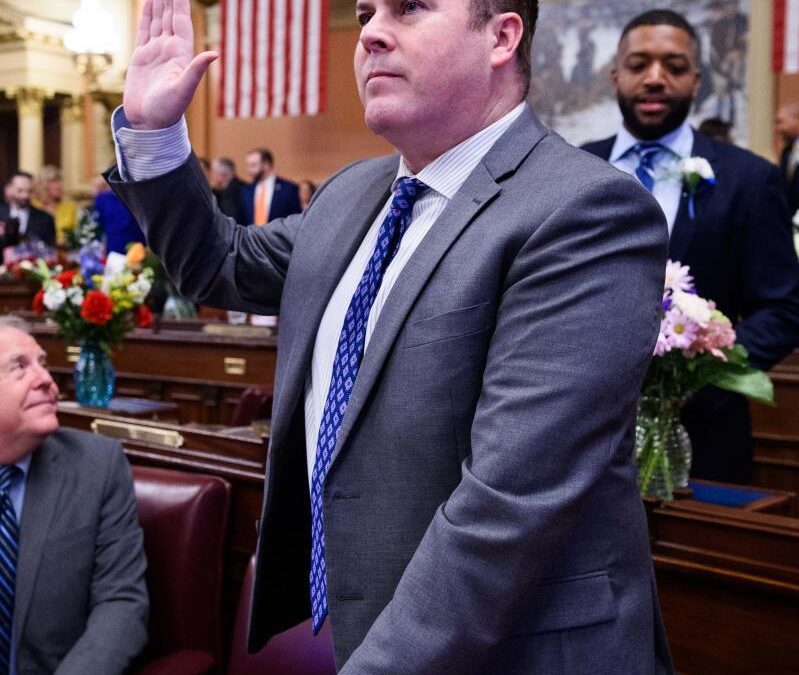
A sign on the back of a truck in the caravan that reads "Do your part, stop the spread and do 2020 Census." Outside the 3rd and Spruce Recreation Center in Reading Friday afternoon September 25, 2020 where the City of Reading held an event to encourage people to fill out the census. (Photo by Ben Hasty/MediaNews Group/Reading Eagle via Getty Images)
The details on how we get sorted into new congressional districts every 10 years.
The race for the White House wasn’t the only big race in 2020. This year the country will undergo a process that happens every 10 years, after the Census is completed: redistricting. And when it comes to power over how that happens, Republicans won big.
Redistricting is the mechanism in which state officials draw new congressional and state legislative districts. Districts are a way to break down a whole state into individual sections that have their own representatives. The House of Representatives, for example, has about 700,000 people living in each congressional district. That number changes along with the Census, as people move away, settle down in new areas, or pass away.
And like so much else, the Census data is delayed this year, thanks to the pandemic. An agency official said they hope to deliver the numbers used for divvying up congressional seats by the end of April. But that timeline could disrupt several states’ abilities to redraw their own legislative maps ahead of upcoming elections.
And exactly how you draw those maps is determined differently in each state. Problems arise when politicians get involved, according to David Daley, a senior fellow at FairVote and the author of “Ratf**ked: The True Story Behind the Secret Plan to Steal America’s Democracy.”
“The trouble is, most states allow politicians and self-interested partisans to be the people who are drawing the lines,” Daley told COURIER.
What Is Gerrymandering, Anyway?
When politically-motivated people take charge of redistricting, it can be easy for them to make elections less competitive by cutting up districts so their voters will always dominate. (This is a practice known as “gerrymandering,” named after Elbridge Gerry, a signer of the Declaration of Independence who redistricted Massachusetts in a way that helped Republicans.) That leads to one party getting an unfair advantage for the next ten years, until the redistricting process starts over again. And that can drastically alter the political landscape in later elections.
You can arguably see this trend in the House. During the 2020 election, Democrats got more than 77 million votes, while Republicans got just over 72 million votes. Given that lead of 5 million votes, you’d think Democrats would hold a decisive lead. Instead, the margin is much slimmer. Republicans control 211 seats, while Democrats have 222.
Mark Rush, the director of the Center for International Education at Washington and Lee University, explained that politicians typically try to draw district lines that will keep them in their position.
“The process, especially over the last couple of decades has become quite contentious as members of either party work hard to draw districts that will save their positions,” Rush told COURIER.
Redrawing district lines can change a whole state and even push a politician out of a job.
“It can have a devastating impact for a politician if their state loses a congressional district because of redistricting,” Rush said. “So it can alter the nature of political competition.”
In 2010, Republicans gained a lot of seats in state legislatures, which gave them the upper hand in drawing new congressional districts that were used in the United States for the next 10 years. They did the same in 2020, as Democrats failed to take any of the state legislatures they targeted.
What a Bad District Looks Like Versus a Good District
To see a politically-driven carve up of congressional districts, look no further than Texas. In the early 2000s, Republicans gained control of the redistricting process, They redrew congressional maps so Republican voters were the majority in more districts, making it harder for Democrats to win. But in order to do that, the districts have odd borders. They often curl around an area to avoid it entirely, and are purposefully irregular. Experts have called Texas’ 2nd district “a result of extreme Republican gerrymandering.” The ward looks more like a coiled snake than a congressional district.
On the other hand, New Mexico is a good example of fair districts, according to Theodore Arrington, a professor at the University of North Caroline at Charlotte who specializes in voting behavior and voting systems.
In New Mexico, after the two parties couldn’t agree on the redrawn maps the process was handed to a special master appointed by the courts.
“He held hearings, looked at various plans and finally adopted maps that were really quite fair,” Arrington said.
Instead of oddly-shaped districts that are clearly drawn to prevent a party from gaining the majority, the state is broken into three wards that make sense, given where the population of the state lives. This gives New Mexicans fair representation in government, and political parties aren’t jostling for control over redistricting every 10 years.
Why Democrats Are at a Disadvantage
Fair district maps are important, in short, because they are key to a truly representative democracy. If political parties make it unfairly difficult to elect candidates they silence the true voice of the people.
Arrington explained that Republicans aren’t the only party at fault for redistricting in an unfair way.
“Democrats aren’t less likely to gerrymander; they don’t have a halo here either,” Arrington said laughing. Instead, factors like geography and the concentration of minorities makes it more difficult for Democrats to gerrymander districts.
“Democratic voters are relatively concentrated [in denser areas] geographically,” Arrington said “and because you have to draw some districts with large concentrations of minority voters because of the Voting Rights Act. It’s very easy for Republicans to draw a gerrymander [and gain the upper hand.]”
The Voting Rights Act prohibits redistricting in a way that discriminates on the basis of race, color or membership to a language minority group. But it doesn’t stop redistricting that happens around a dense population that gives more power to a certain political party.
But Things May Be Looking Up…
States like California, Arizona, and Iowa have adopted measures like bipartisan or nonpartisan commissions to do the redistricting. Arrington says those groups “do a better job than state legislatures.”
Daley predicts that stopping gerrymandering, especially in states that have a history of unfairly drawn districts, will take more “citizen outrage.”
“In most of these states where an initiative is possible, it’s been tried. Everybody hates gerrymandering except for the politicians who do it,” Daley said.
He explained that aside from a popular vote, citizens have to specifically ask to see progress.
“Citizens in Virginia did not go the initiative route, they had to show up in Richmond at the Capitol and lobby and organize and demand change,” Daley said.
Last year, Virginia created a bipartisan commission of eight lawmakers and eight citizens to redraw congressional maps after years of lawsuits over previous maps. The momentum for the change came from the citizens who lobbied political leaders and encouraged changing the process.
This time around, Republicans throughout the country will control the redistricting of 188 congressional seats versus Democrats controlling 73 seats, according to FiveThirtyEight.
But Arrington notes that many states have enacted their own legislation to make redistricting more fair. So, at the very least the process could be more equitable than it was in 2010.
“That doesn’t mean there won’t be some gerrymandering. There will be. But there will be a lot less than there was 10 years ago,” he said.
RELATED: Majority-GOP Legislature Wants to Change Makeup of State Courts in Its Favor
Politics

Philadelphia DA cancels arrest warrant for state Rep. Kevin Boyle on eve of Pa. primary
Philadelphia District Attorney Larry Krasner said a detective had sought the warrant against Boyle, a Democrat whose district includes a section of...

Influencers and creators find new ways to engage young Philadelphia voters
Rec Philly, a space for creators and influencers, teamed up with Show Up Strong to get hundreds of young Philadelphia residents engaged in the...

New Biden rule protects privacy of women seeking abortions
Under the new rules, state officials and law enforcement cannot obtain medical records related to lawful reproductive health care with the goal of...
Local News

Conjoined twins from Berks County die at age 62
Conjoined twins Lori and George Schappell, who pursued separate careers, interests and relationships during lives that defied medical expectations,...

Railroad agrees to $600 million settlement for fiery Ohio derailment, residents fear it’s not enough
Norfolk Southern has agreed to pay $600 million in a class-action lawsuit settlement for a fiery train derailment in February 2023 in eastern Ohio,...





